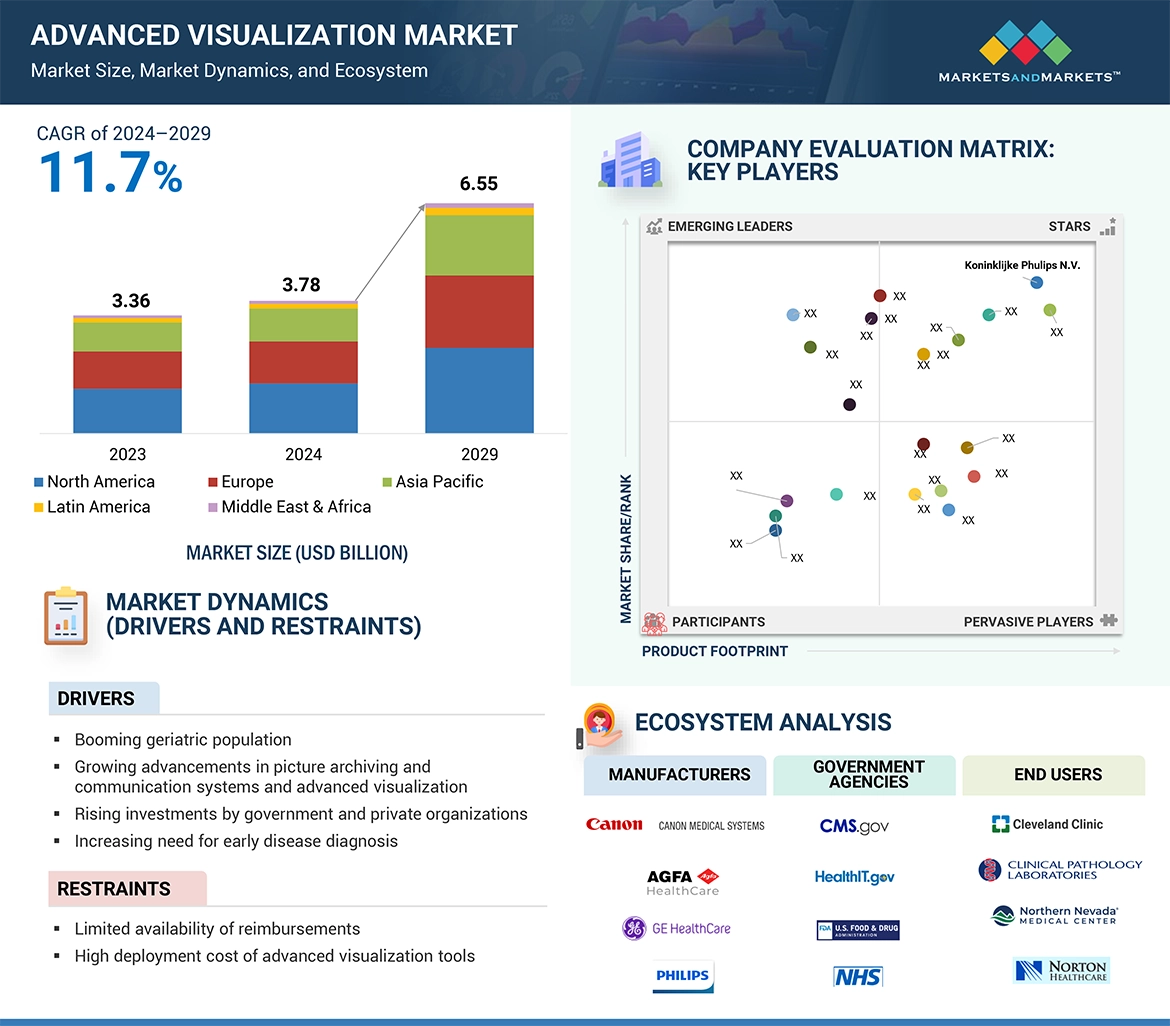The global Advanced Visualization market is expected to grow to USD 6.55 Billion by 2029, up from USD 3.78 Billion in 2024, at a CAGR of 11.7% over the forecast period. The market for advanced visualization solutions is expanding rapidly owing to a number of factors. The growing focus on value-based care, increasing establishment of hospitals & diagnostic imaging centers, the surging demand for AI & data analytics for diagnostics & imaging, and the emerging economies like China, India, Brazil, South Korea, etc. offer lucrative opportunities for the growth of the market. However, the shortage of skilled professionals to operate visualization tools, and the hospital budget cuts are some of the factors that challenge market growth.
Download PDF Brochure: https://www.marketsandmarkets.com/pdfdownloadNew.asp?id=111936030

Browse in-depth TOC on “Advanced Visualization Market”
455 – Tables
54 – Figures
386 – Pages
Artificial Intelligence (AI) and Machine Learning (ML) are revolutionizing advanced visualization by enabling advanced data analysis, pattern recognition, and predictive modelling, which are crucial for early disease diagnosis to improve diagnostic efficiency & accuracy. Companies are investing in leveraging AI & ML across their product lifecycles. Augmented reality is another technology being integrated with advanced visualization tools to enhance the visualization capabilities. For instance, in June 2024, GE Healthcare and MediView announced the world’s first installation & clinical use of OmnifyXR Interventional Suite, an augmented reality-based interventional radiology suite combines a holographic heads-up display streaming live medical imaging, 3D anatomy model visualization and advanced imaging technologies.
The global advanced visualization market is segmented into enterprise-wide thin client-based and standalone workstation-based solutions, by type. The enterprise-wide thin client-based solutions segment is accounted for the largest share & is also expected to register highest growth during the forecast period. The large share & high growth of this market is driven by the their scalability, cost-effectiveness, and access high-quality imaging and analysis tools from any location using a simple device like a laptop or tablet. Thin-client solutions enable centralized management, allowing healthcare networks to efficiently deploy and maintain advanced visualization tools across multiple locations without the need for costly high-powered workstations. a. Its ability to integrates various imaging modalities and advanced software solutions to enhance diagnostic accuracy across healthcare systems further fuels the market growth.
The advanced visualization market is divided into services, software, and hardware by offering. In 2023, the services segment is expected to demonstrate highest growth rate during the forecast period. The high adoption of advanced visualization services over software is driven by the need for specialized expertise and tailored solutions that go beyond the capabilities of standalone software. Increased security, improved cost effectiveness, better usability & flexibility, and improved integration capabilities of services are a few factors impacting market growth. Moreover, the escalating user base and changing needs of companies looking for all-inclusive solutions and support, coupled with the adoption of advanced visualization software, generate demand for a range of services, including training, implementation, and consulting.
The integration of advanced visualization (AV) solutions with Picture Archiving and Communication Systems (PACS) is vital for enhancing diagnostic capabilities. This integration allows AV tools to access and retrieve images stored in PACS, including DICOM, to ensure compatibility. By enabling advanced techniques such as 3D reconstruction and image processing directly on PACS data, clinicians can analyze images more efficiently without needing to switch systems, which helps in improving diagnostic accuracy. Additionally, this integration promotes secure data transfer and fosters collaboration among healthcare professionals. It enables multiple specialists to review advanced visualizations together, enhancing the decision-making process.
Request Sample Pages : https://www.marketsandmarkets.com/requestsampleNew.asp?id=111936030
The prominent players operating in the advanced visualization market include Agfa-Gevaert Group (Belgium), Canon Medical Systems Corporation (Japan), Fujifilm Holdings Corporation (Japan), GE Healthcare (US), Koninklijke Philips N.V. (Netherlands), Siemens Healthineers AG (Germany), Stryker (US), Change Healthcare (US), TeraRecon (US), Ziosoft (Japan), Pro Medicus, Ltd (Australia), Carestream Health (US), Fovia, Inc. (US), 4DMedical (Australia), Synopsys, Inc. (US), Novarad (US), AnalyzeDirect, Inc. (US), Syntermed Inc. (Netherlands), Pie Medical Imaging B.V. (Netherlands), Infinitt Healthcare Co., Ltd. (US), Biotronics 3D (UK), Minnovaa Innovations Oü (Estonia), Postdicom (Netherlands), CitiusTech Inc (US), Ceevra, Inc. (US). These companies adopted strategies such as product launches, product updates, expansions, partnerships, collaborations, mergers and acquisitions to strengthen their market presence in the advanced visualization market.
Koninklijke Philips N.V. (Netherlands) is one of the key players that offers advanced visualization solutions that enhance diagnostic capabilities and streamline workflows. The company’s AV solution provides an image post-processing platform that integrates within healthcare enterprises across multiple modalities, such as MRI and CT. The company provides its AV solutions to clinical specialties, including cardiology, oncology, and radiology. Philips offers products like imaging systems and image-guided therapy solutions, offers advanced visualization tools and software, supporting enhanced diagnostic processes for healthcare providers. Philips has a significant global presence, serving over 100 countries across North America, Europe, Asia-Pacific, Latin America, and Africa. Its operations are supported by a strong network of subsidiaries, including Philips Healthcare, Philips Medical Systems, and Philips Research. The company maintains strategic R&D centers in key markets and collaborates with leading medical institutions to drive innovation in health technology.
Canon Medical Systems Corporation (Japan) is one of the leading providers of medical imaging technologies, specializing in advanced visualization solutions through its flagship platform, Vitrea. The company provides advanced algorithms and artificial intelligence. The platform enhances image quality and diagnostic accuracy across modalities such as CT, MRI, and ultrasound. The company solutions cover a wide range of clinical applications, including enhanced diagnostics, oncology, cardiovascular assessments, and orthopedic analysis. It has 13 subsidiaries located outside Japan and serves more than 150 countries across the globe.
For more information, Inquire Now!
